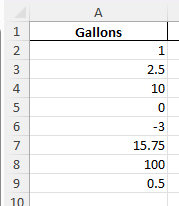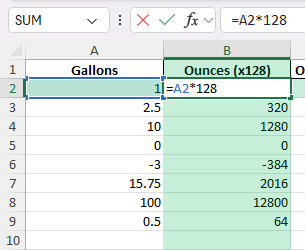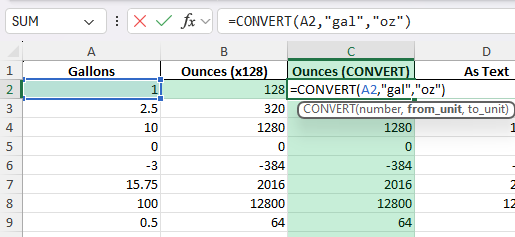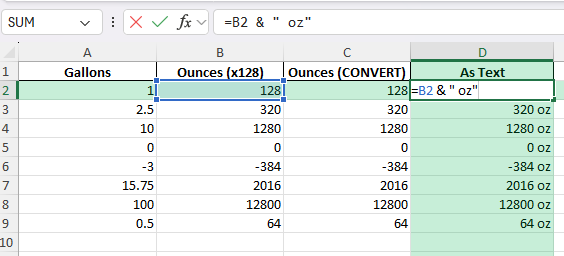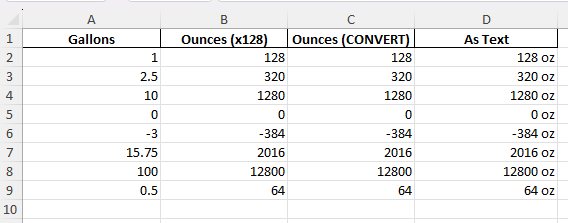If you manage recipes, inventory lists, or fluid measurements, you may need to convert gallons to ounces in Excel. This is a common task in food services, manufacturing, science labs, and logistics. Rather than converting values one by one, Excel allows you to automate the conversion across any dataset, ensuring accuracy and saving time. In this post, you’ll learn how to convert gallons to ounces in a few easy steps, including advanced tips for large or complex sheets.
Key Takeaways
- There are 128 ounces in 1 US liquid gallon.
- You can use a simple multiplication formula:
=A2*128to convert gallons to ounces. - The
CONVERTfunction in Excel can also handle this conversion:=CONVERT(A2,"gal","oz"). - Helper columns keep your calculations organized and easy to audit.
- Power Query and VBA can automate conversions for large or dynamic datasets.
Table of Contents
Understanding Gallons and Ounces
What is a Gallon?
A gallon is a unit of volume commonly used in the United States for measuring larger quantities of liquid. It is a staple for quantifying liquids like milk or gasoline. In the U.S., a gallon equals 128 fluid ounces, distinct from the British gallon, which is larger, equating to approximately 160 U.S. ounces. Knowing these differences is crucial when dealing with recipes or products that might use different standards.
The Basics of Fluid Ounces
Fluid ounces are a smaller unit of volume measurement often used for precise liquid measurements. In the United States, one fluid ounce equates to 1/128 of a gallon, or approximately 29.5735 milliliters. This measure is particularly handy for beverages or cooking ingredients that require exact amounts. Fluid ounces allow for easy scaling and conversion, especially when you are adjusting recipes or managing portion sizes.
How to Convert Gallons to Ounces in Excel
Step 1: Enter Your Gallon Values
Type your gallon values in column A, starting in A2 (e.g., 1, 2.5, 10, etc).
Step 2: Convert Gallons to Ounces Using a Formula
In cell B2, enter:
=A2*128
This multiplies the gallon value by 128 to get the ounces.
Copy the formula down for the rest of your dataset.
Step 3: Convert Gallons to Ounces with the CONVERT Function
In cell C2, enter:
=CONVERT(A2,"gal","oz")
This is a built-in Excel function for unit conversions.
Step 4: Add a Label or Output Column
In cell D2, enter:
=B2 & " oz"
This creates an easy-to-read label for reports or exports.
Common Mistakes and Tips
Mistake: Using the wrong conversion factor
Use 128 for US gallons, not 160 (which is for UK gallons).
Mistake: Confusing weight ounces with fluid ounces
This method is for fluid ounces. If you are working with weight, check your units.
Tip: Use absolute references for the conversion factor
Place 128 in a helper cell (e.g., E1) and use =A2*$E$1 for flexibility.
Tip: Clearly label your columns
Make sure everyone knows the units (Gallons, Ounces).
Tip: Use helper columns for audit trails
Keep your raw data, converted values, and labels in separate columns.
Bonus Tips and Advanced Scenarios
VBA Macro for Bulk Conversion
Use this VBA macro to convert gallons to ounces in a selected range:
Sub ConvertGallonsToOunces()
Dim cell As Range
For Each cell In Selection
If IsNumeric(cell.Value) Then
cell.Offset(0, 1).Value = cell.Value * 128
End If
Next cell
End Sub
This macro writes the ounce result in the next column.
Power Query for Automated Conversion
Add a custom column:
=[Gallons] * 128
Convert in Reverse (Ounces to Gallons)
Use =A2/128 for ounces to gallons.
Real-World Applications of Gallon-to-Ounce Conversions
Cooking and Recipes
Converting gallons to ounces is highly practical in the kitchen, especially when dealing with large batches or scaling recipes up or down. A recipe might ask for ingredients listed in gallons, yet measuring them in ounces ensures precision, especially in baking, where the exact liquid quantity can significantly affect the outcome. For example, if a soup recipe requires one gallon of broth, converting it to 128 ounces enables you to measure it accurately using standard kitchen tools.
Hydration Goals
Meeting daily hydration goals can be simplified by converting gallons to ounces, making it easier to track fluid intake. Health guidelines often recommend drinking around half a gallon of water a day, equal to 64 ounces. This conversion helps people visualize and manage their consumption more effectively, using common water bottles or cups measured in ounces. Monitoring this can contribute significantly to maintaining optimal health and well-being.
Grocery Shopping
During grocery shopping, understanding gallon-to-ounce conversions assists in comparing product sizes and prices efficiently. Many bulk liquid products are sold by the gallon, but converting this to ounces helps assess whether purchasing a larger container is more economical compared to smaller ones priced in ounces. Being adept at these conversions fosters smarter spending decisions and can lead to significant savings over time.
FAQ
Q: What is the formula to convert gallons to ounces in Excel?
A: =A2*128 for US gallons.
Q: Can I use the CONVERT function for this?
A: Yes, use =CONVERT(A2,"gal","oz"). Ensure the Analysis ToolPak is enabled.
Q: How do I convert ounces back to gallons?
A: Use =A2/128.
Q: What if I need UK gallons?
A: Use 160 as the conversion factor, or =CONVERT(A2,"uk_gal","uk_oz") if supported.
Q: Can I automate this for thousands of rows?
A: Yes, use Power Query or the VBA macro provided for bulk conversions.
John Michaloudis is a former accountant and finance analyst at General Electric, a Microsoft MVP since 2020, an Amazon #1 bestselling author of 4 Microsoft Excel books and teacher of Microsoft Excel & Office over at his flagship MyExcelOnline Academy Online Course.

